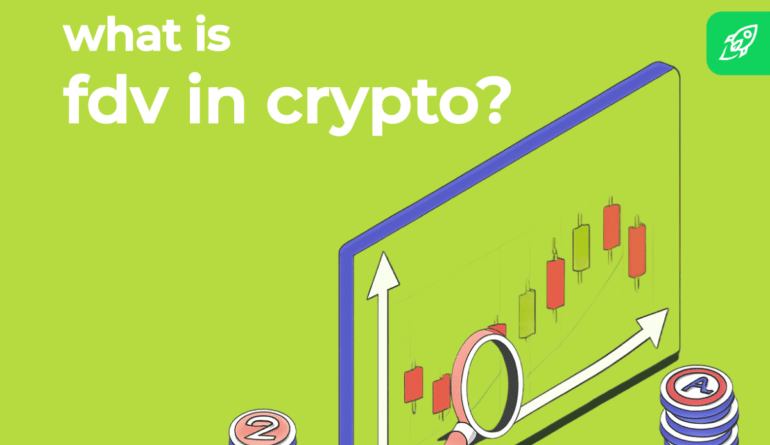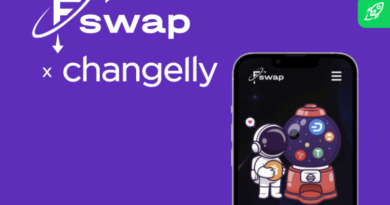Fully Diluted Valuation (FDV) in Crypto Explained: What It Is and Why It Matters
In crypto investing, it’s easy to focus only on what you see: the price, trading volume, and market cap. But these numbers often hide the bigger picture. Fully Diluted Valuation helps uncover that by showing the total potential value of a cryptocurrency project if all tokens were in circulation. If you’ve ever wondered, “what is FDV in crypto?” and why it matters, you’re not alone.
FDV helps investors understand how token supply might evolve and what that means for value over time. As more tokens are unlocked or minted, the market can change quickly—especially if demand is variable. Whether you’re comparing new coins or managing risk, understanding FDV gives you another layer of insight for making more informed decisions.
What is Fully Diluted Valuation (FDV)?
Fully Diluted Valuation (FDV) shows the total value of a cryptocurrency if all tokens that could ever exist were already in circulation. It answers one key question: What would this project be worth if every token were already released?

FDV is calculated using the current token price and the total supply. This includes both the tokens already in the market and those that are locked, reserved, or yet to be issued.
Here’s a simple analogy. Imagine a bakery plans to bake 1,000 loaves of bread, but only 300 are on the shelves today. If each loaf sells for $5, the bakery now has $1,500 worth of bread. But if you count the full 1,000 loaves it plans to bake, the value becomes $5,000. FDV works the same way—it estimates the value based on the total supply, not just what’s available right now.
Fully Diluted Valuation helps you understand the long-term scale and future potential of a project. If a significant portion of tokens is still locked or unreleased, FDV tells you how large the project’s market value could become as those tokens enter circulation.
FDV vs. Market Capitalization
Although market capitalization (or market cap) and Fully Diluted Valuation (FDV) may seem similar, they represent different snapshots of value—one in the present, the other in a possible future.
Market cap is calculated by multiplying the current price of a token by its circulating supply—the number of tokens already available on the market. This gives you the project’s current market value based on real-time trading activity. In contrast, FDV uses the same token price but multiplies it by the total number of tokens that could ever exist, including those that are still locked, reserved, or not yet issued. This means FDV represents the project’s potential future value, assuming full issuance of tokens.
Read more: What is circulating supply?
These two metrics often differ widely. If a large portion of tokens is still locked, FDV can be several times higher than the current market cap. This gap warns investors about possible dilution, especially in newer projects with long vesting schedules or aggressive token unlocks.
Here’s a quick comparison:
Understanding both FDV and market cap helps you evaluate not just where a project stands now, but also where it might head as its total supply unlocks over time.
How Is FDV Calculated?
Fully Diluted Valuation (FDV) is calculated using a simple formula:
FDV = Current Token Price × Total Token Supply
The token’s total supply equals the maximum number of tokens that will ever exist for a given project. It does not depend on the circulating supply.
Let’s say a cryptocurrency token is trading at $2, and its total supply is 100 million tokens, while the number of its circulating tokens is only 20 million.
FDV = $2 × 100,000,000 = $200,000,000
Meanwhile, its current market capitalization will only be $2 x 20,000,000 = $40,000,000.
In this case, FDV is $200 million, even if only 20 million tokens are currently circulating. This shows the token’s potential total market value if all tokens were released.

Why FDV Matters to Investors
Fully Diluted Valuation (FDV) gives you a realistic view of a crypto project’s long-term value, including the impact of future token releases. A large gap between FDV and market cap means many tokens are still locked. When these tokens enter circulation, they can increase supply and drive down the price if demand doesn’t keep up.
A high FDV with a small circulating supply often signals overvaluation, especially if the project lacks strong fundamentals or active user demand. This directly affects your investment decisions. Two projects might share the same market cap, but the one with more tokens locked carries greater dilution risk.
By comparing FDV and market cap, you can spot inflated valuations early and focus on projects with more sustainable tokenomics.
Limitations of FDV
While Fully Diluted Valuation (FDV) can help you understand the potential scale of a cryptocurrency project, relying on it alone can be misleading. It assumes that a token’s current price will remain the same even as more tokens enter circulation. In reality, this rarely holds true, especially when supply and demand shifts over time.
FDV Ignores Market Dynamics
FDV does not account for how prices change as new tokens are released. It multiplies the current price by the total supply, assuming no impact from dilution or changing investor sentiment. But once future supply enters the market, prices often adjust. If demand doesn’t rise to match the larger supply, the token’s value typically drops. This makes FDV a poor predictor of future prices unless combined with an understanding of market behavior.
Not Useful for Early-Stage Projects
For crypto projects with a low market cap and high FDV, the number might look impressive—but it can be deceptive. Many of these projects are in early development stages, and their full supply may not be released for years. In such cases, FDV exaggerates their current worth. Unlike in the stock market, where a company’s valuation reflects existing performance and revenue, FDV in crypto can be inflated by speculation and vesting schedules.
FDV Treats All Tokens Equally
FDV assumes every token has the same economic weight, whether it’s circulating freely or locked in smart contracts, team wallets, or treasuries. But not all tokens enter the market under equal conditions. Tokens released to the team, for example, may not be sold immediately. FDV overlooks this nuance, which can result in misleading comparisons between projects with very different token distributions.
Become the smartest crypto enthusiast in the room
Get the top 50 crypto definitions you need to know in the industry for free

Lacks Context Without Other Metrics
FDV must be viewed alongside other metrics like market capitalization, the number of tokens in circulation, unlock schedules, and real user adoption. On its own, it offers an incomplete picture. A token with high FDV might seem overvalued, but if it has strong fundamentals and clear future growth potential, it could still be a smart investment. Without this context, FDV can lead to poor conclusions and limit your ability to make informed investment decisions.
How Token Unlocks and Burns Affect FDV
Understanding the limitations of FDV means going beyond the headline number. While FDV uses a project’s max supply, it doesn’t explain how or when that supply will enter the market—or whether it might even shrink over time. This is where token unlock schedules, emission models, and burn mechanisms become essential for interpreting FDV in a real-world context.
Token Unlocks and Vesting Schedules
Many projects reserve large portions of their token supply for their own teams, early investors, or ecosystem development. These tokens are often locked at launch and released over months or years through a vesting schedule. Although FDV includes these unreleased tokens, the market impact depends on when and how fast they’re unlocked.
For example, if a project unlocks millions of tokens each month, that creates constant sell pressure—even if FDV stays the same. In contrast, a project with a slow or delayed unlock schedule gives demand time to grow, which reduces the risk of dilution. Tools like token.unlocks.app help track these events and understand when new supply will hit the market.
Emissions and Inflationary Supply
Some protocols don’t have a hard cap. They mint new tokens indefinitely to fund staking rewards or security incentives. In those cases, FDV can rise over time as the maximum supply increases. This creates ongoing inflation, making FDV a moving target rather than a static benchmark. For investors, it’s critical to assess whether the project’s utility and demand can keep pace with this expanding supply.
Token Burning and Supply Reduction
In contrast to inflationary models, some projects use token burning to reduce their supply over time. This mechanism permanently removes tokens from circulation—either through transaction fees, buyback-and-burn models, or deflationary smart contracts. When tokens are burned, the max supply decreases, which lowers FDV.
Projects like Binance Coin (BNB) and Ethereum (post-EIP-1559) implement burning as part of their tokenomics. In these cases, FDV can trend downward over time if the burn rate is sustained. This helps counteract dilution and may support long-term price stability.
Tools to Track FDV and Tokenomics
Accurate analysis of FDV and tokenomics requires reliable data and insights. Here are the leading platforms and tools you can use:
CoinGecko
CoinGecko displays FDV (fully diluted valuation) alongside market cap and other important metrics for most tokens. Their interface allows you to toggle FDV view and directly compare market cap and FDV on the same page. It also features a “Market Cap / FDV” metric—showing how close a token is to full issuance. CoinGecko is excellent for quick visual snapshots and ongoing monitoring of token release impact.

Tokenomist.ai
Tokenomist.ai specializes in supply-side tokenomics analytics. It tracks vesting schedules, upcoming token unlocks, and total supply evolution. This lets you anticipate changes in FDV and understand when future supply might dilute prices.
CoinMarketCap & Other Analytics Platforms
Major crypto data platforms like CoinMarketCap, Messari, Nansen, Glassnode, and Token Terminal support FDV and tokenomics tracking. These services go beyond just token supply—they offer on-chain metrics, developer activity, and user engagement patterns, helping you connect FDV numbers with real project health indicators.
Blockchain Explorer & Project Documentation
To verify fundamental data (like max supply and total supply), always check official sources—token whitepapers or on-chain data verified by smart contracts. Some explorers and dashboards let you monitor FDV evolution over time and visualize potential dilution when new tokens are scheduled to enter circulation.
Final Thoughts
FDV is one of the most important metrics for evaluating the future potential of a cryptocurrency project. It shows how increasing token supply could affect valuation and helps highlight risks that aren’t obvious from market cap alone. While it’s easy to calculate FDV using a simple formula, most platforms like CoinGecko and CoinMarketCap already display it alongside real-time data, so you don’t need to crunch numbers yourself.
Still, FDV isn’t a standalone answer by itself. The market cap reflects current value, while FDV projects a possible future. The truth lies somewhere in between. Use FDV as part of a broader strategy—alongside unlock schedules, token burns, demand analysis, and real project fundamentals—to make smarter, long-term crypto decisions.
FAQ
Is high FDV good or bad?
A high fully diluted market cap isn’t automatically good or bad—it depends on context. It may signal strong future potential, or it could warn of future dilution if a large number of tokens is yet to be released and demand doesn’t grow with supply.
What is a good FDV ratio?
There’s no universal “good” FDV ratio, but comparing market cap to FDV helps. A low market cap-to-FDV ratio (e.g. 0.1–0.3) suggests a lot of future supply is still locked, while a ratio closer to 1 indicates most tokens are already in circulation. Always compare ratios within the same sector for meaningful insights.
What does a low FDV mean?
A low FDV may indicate that a token is near full circulation, with little future dilution expected. But it can also suggest limited future growth, especially if the project has no plans for expansion or utility development.
Why is FDV higher than market cap?
FDV is usually higher than market cap because it includes the total maximum supply, while market cap only reflects circulating tokens. If a project has many tokens locked for team, staking, or future incentives, this gap can be significant.
Why is FDV so different from market cap for some coins?
The difference often comes down to token unlock schedules, inflationary emissions, or delayed vesting. Some projects may have a small circulating supply now, but plan to issue many more tokens over time, which inflates FDV even if the current value is low. Always check the smart contract details and supply timelines before making assumptions.
Disclaimer: Please note that the contents of this article are not financial or investing advice. The information provided in this article is the author’s opinion only and should not be considered as offering trading or investing recommendations. We do not make any warranties about the completeness, reliability and accuracy of this information. The cryptocurrency market suffers from high volatility and occasional arbitrary movements. Any investor, trader, or regular crypto users should research multiple viewpoints and be familiar with all local regulations before committing to an investment.
The post Fully Diluted Valuation (FDV) in Crypto Explained: What It Is and Why It Matters appeared first on Cryptocurrency News & Trading Tips – Crypto Blog by Changelly.
Cryptocurrency News & Trading Tips – Crypto Blog by Changelly




















